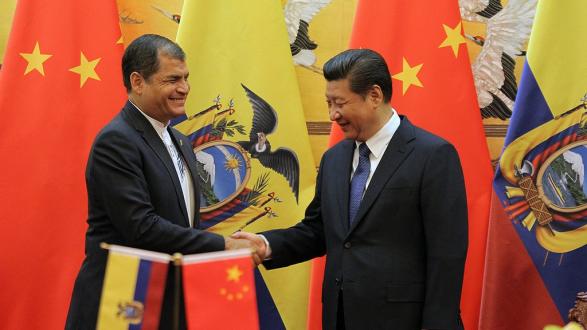China’s agenda in Latin America is purely economic, not political or security related, Dr. Lourdes Casanova and Mr. Peter Hakim told Pacific Council members in a Situation Briefing teleconference.
Casanova is the academic director of Cornell University’s Emerging Markets Institute. Hakim is the president emeritus and a senior fellow at the Inter-American Dialogue. The discussion was moderated by Dr. Saori Katada, an associate professor of international relations at the University of Southern California.
"There’s very little evidence that China wants anything more than just economic relations in Latin America," said Hakim. "Both China and Latin America want to sustain their economic relationship."
There is increased speculation that China may replace the United States as a stronghold in Latin America, following rhetoric from U.S. leadership on trade and immigration. Bilateral trade between China and Latin America grew 2,400 percent between 2000 and 2013 and Chinese President Xi Jinping visited several Latin American countries only days after Donald Trump won the U.S. election in November 2016.
"There’s very little evidence that China wants anything more than just economic relations in Latin America."
Peter Hakim
Casanova and Hakim pointed out that Chinese leaders visit Latin America more often than U.S. leaders do, but that relations between Latin America and China are nothing new. Trade in the region dates back centuries.
"Trade relations between China and Latin America are strong, but increasingly China is also playing the role of the main investor in the region," said Casanova. "China has become the main trading partner of a number of countries in the region, including Venezuela, Peru, Brazil, and Chile, as well as the second biggest trading partner of Latin America after the United States. China has been key for the boom years of Latin America, but now we are in another phase. It remains to be seen how Latin American governments will react to China’s new role as a major investor in the region."
Hakim said it would have been difficult to imagine in the early 2000s the kind of presence China now enjoys in the region.
"It was almost like the expansion of the universe after the Big Bang," he said. "China was not on the map in Latin America. There were so many other countries that were doing far more business and politics with Latin America. Now China is the largest trading partner of South America. China has come on very strongly. They began to finance through loans a variety of construction projects, mainly having to do with their own access to commodities. They built better ports, highways, and railroads to facilitate that access. Now China is investing in many of the companies in the region, but I don’t think it exceeds the United States on investment yet."
"What worries me is that China has a clear strategy for Latin America, but Latin America does not have a strategy for China."
Lourdes Casanova
Casanova added that China is the most important trading partner for many countries, not just Latin American countries, so relations between China and Latin America should be kept in perspective.
Hakim said that China has laid out a specific strategy about their intentions in Latin America.
"They certainly lay out very clearly what their objectives are and where they want to be," he said. "Not surprisingly, at this point not a single Latin American country has much of a strategy for dealing with the influx of Chinese investment. Certainly there’s no coordination between the countries."
Casanova is also concerned that Latin America does not have a strategy for China’s increased presence.
"What worries me is that China has a clear strategy for Latin America, but Latin America does not have a strategy for China," she said. "They don’t have a five-year plan, they don’t have a plan for the short, medium, or long term. Brazil is being forced to sell and to do whatever is needed to get out of its economic crisis and grow again. In this rush to get funds from China, Brazil has not had time to think about what it needs to do in the next four to five years. They need to develop a win-win strategy so that Latin American countries also benefit from this new relationship."
"Ultimately, Latin America is doing what it has to do to find new revenues of investment and trade."
Peter Hakim
Hakim said there is little reason to expect any deliberate slowdown from China.
"China looks at Latin America as an important source of many of the things China needs for its continuing rapid development at home," he said. "Latin America has really welcomed the Chinese."
That said, Hakim does not believe that China is going to displace the United States in Latin America, just that its economic ties and influence are certain to grow.
"The question is, will Trump’s attitude to trade and overseas production mean a U.S. retreat from Latin America?" said Hakim. "Ultimately, Latin America is doing what it has to do to find new revenues of investment and trade."
Listen to the full conversation below:
____________________
Justin Chapman is the Communications Associate at the Pacific Council on International Policy.
The views and opinions expressed here are those of the speakers and do not necessarily reflect the official policy or position of the Pacific Council.




